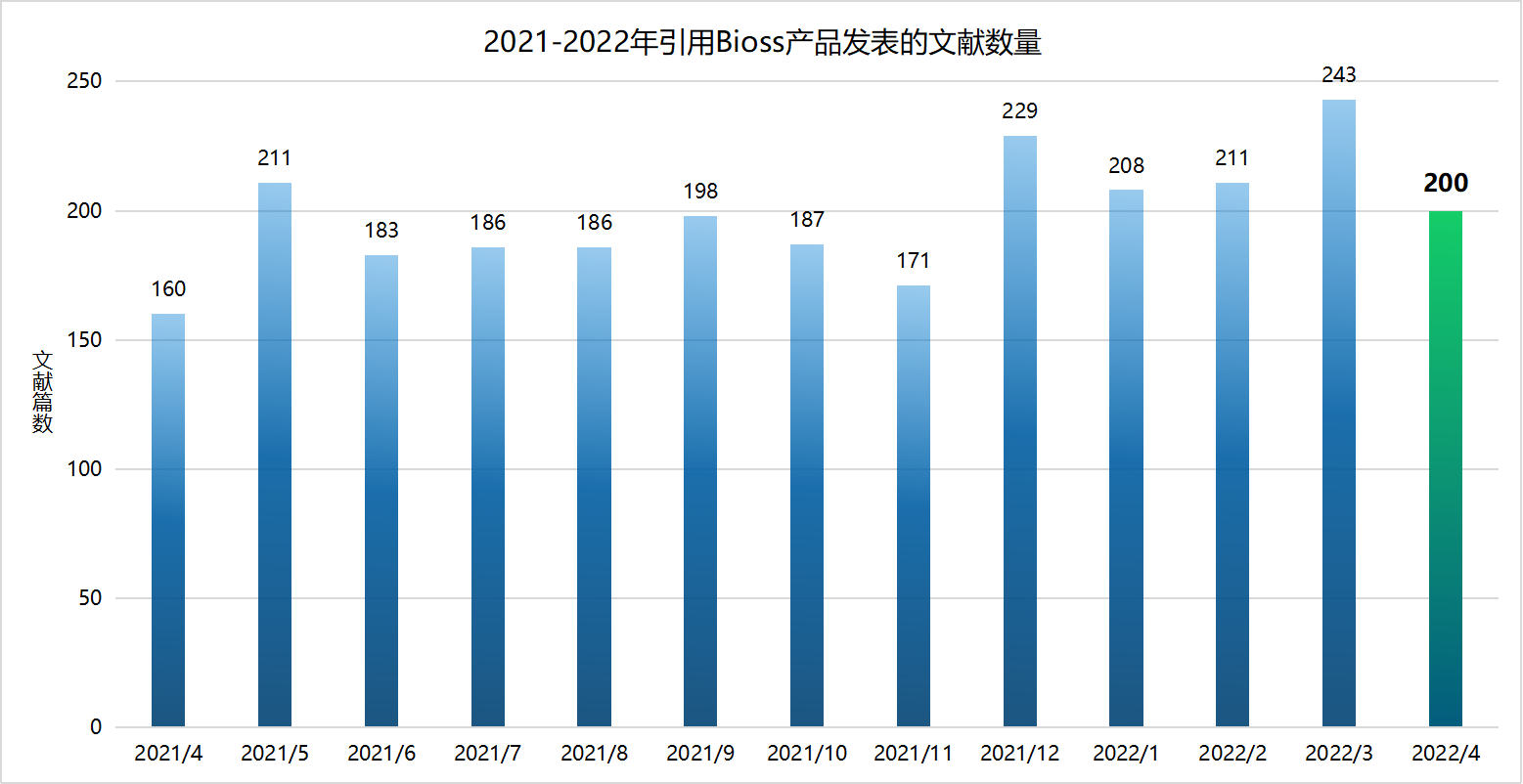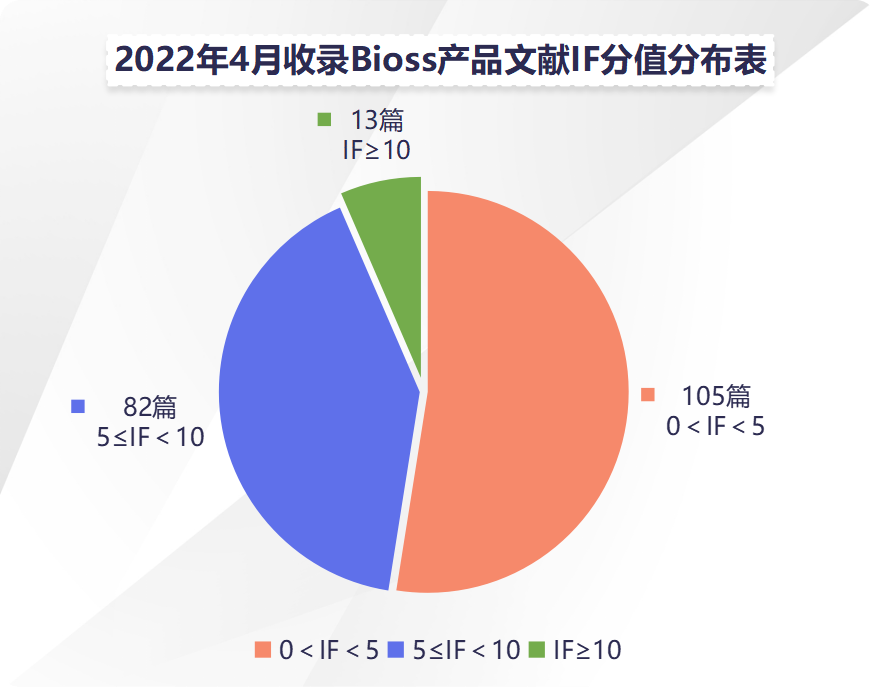截止目前,引用Bioss产品发表的文献共18150篇,总影响因子78229.601分,发表在Nature/Science/Cell/Immunity等顶级期刊的文献共52篇,合作单位覆盖了清华、北大、复旦、华盛顿大学、麻省理工学院、东京大学以及纽约大学等国际知名研究机构上百所。 近期收录2022年4月引用 Bioss 产品发表的文献共200篇(图一),文章影响因子总和高达1110.664分,其中10分以上文献有13篇,20分以上文献有2篇(图二)。 图一 图二 Cell Metabolism [IF=27.287] bsm-0978M (Anti-GAPDH mAb; WB) 摘要:Emerging evidence indicates that the accretion of senescent cells is linked to metabolic disorders. However, the underlying mechanisms and metabolic consequences of cellular senescence in obesity remain obscure. In this study, we found that obese adipocytes are senescence-susceptible cells accompanied with genome instability. Additionally, we discovered that SREBP1c may play a key role in genome stability and senescence in adipocytes by modulating DNA-damage responses. Unexpectedly, SREBP1c interacted with PARP1 and potentiated PARP1 activity during DNA repair, independent of its canonical lipogenic function. The genetic depletion of SREBP1c accelerated adipocyte senescence, leading to immune cell recruitment into obese adipose tissue. These deleterious effects provoked unhealthy adipose tissue remodeling and insulin resistance in obesity. In contrast, the elimination of senescent adipocytes alleviated adipose tissue inflammation and improved insulin resistance. These findings revealed distinctive roles of SREBP1c-PARP1 axis in the regulation of adipocyte senescence and will help decipher the metabolic significance of senescence in obesity.

Autophagy [IF=16.016] 文献引用抗体: bs-1353R (Anti-BECN1 pAb; IF) bs-0295D-AF555 (Donkey Anti-rabbit IgG H&L/AF555; IF) bs-0296R-AF488 (Rabbit Anti-Mouse IgG H&L/AF488; IF) 摘要:Macroautophagy/autophagy is a cellular and energy homeostatic mechanism that contributes to maintain the number of primordial follicles, germ cell survival, and anti-ovarian aging. However, it remains unknown whether autophagy in granulosa cells affects oocyte maturation. Here, we show a clear tendency of reduced autophagy level in human granulosa cells from women of advanced maternal age, implying a potential negative correlation between autophagy levels and oocyte quality. We therefore established a co-culture system and show that either pharmacological inhibition or genetic ablation of autophagy in granulosa cells negatively affect oocyte quality and fertilization ability. Moreover, our metabolomics analysis indicates that the adverse impact of autophagy impairment on oocyte quality is mediated by downregulated citrate levels, while exogenous supplementation of citrate can significantly restore the oocyte maturation. Mechanistically, we found that ACLY (ATP citrate lyase), which is a crucial enzyme catalyzing the cleavage of citrate, was preferentially associated with K63-linked ubiquitin chains and recognized by the autophagy receptor protein SQSTM1/p62 for selective autophagic degradation. In human follicles, the autophagy level in granulosa cells was downregulated with maternal aging, accompanied by decreased citrate in the follicular fluid, implying a potential correlation between citrate metabolism and oocyte quality. We also show that elevated citrate levels in porcine follicular fluid promote oocyte maturation. Collectively, our data reveal that autophagy in granulosa cells is a beneficial mechanism to maintain a certain degree of citrate by selectively targeting ACLY during oocyte maturation.
JCI【IF=14.808】 文献引用抗体: 作者单位:日本爱媛大学高级研究支持中心实验动物研究部 摘要:Rheumatoid arthritis (RA) is characterized by chronic synovial inflammation with aberrant epigenetic alterations, eventually leading to joint destruction. However, the epigenetic regulatory mechanisms underlying RA pathogenesis remain largely unknown. Here we showed that Ubiquitin-like containing PHD and RING finger domains 1 (UHRF1) is a central epigenetic regulator that suppressively orchestrates multiple pathogeneses in RA. UHRF1 expression was remarkably up-regulated in synovial fibroblasts (SF) from arthritis model mice and RA patients. Mice with SF-specific Uhrf1 conditional knockout showed more severe arthritic phenotypes than littermate control. Uhrf1-deficient SF also exhibited enhanced apoptosis resistance and up-regulated expression of several cytokines including Ccl20. In RA patients, DAS28, CRP, and Th17 accumulation as well as apoptosis resistance were negatively correlated with UHRF1 expression in synovium. Finally, Ryuvidine administration that stabilizes UHRF1 ameliorated arthritis pathogeneses in a mouse model of RA. This study demonstrated that UHRF1 expressed in RA SF can contribute to negative feedback mechanisms that suppress multiple pathogenic events in arthritis, suggesting that targeting UHRF1 could be one of the therapeutic strategies for RA.
CEJ【IF=13.273】 bs-6194R (Anti-Sclerostin pAb; Other) 摘要:Biomaterial-based tissue engineering has emerged as a hotspot in the field of osteanagenesis. Due to invasive operation in the transplantation process always bring irreparable damage to patients, approaches that enable innate repair mechanisms hold considerable promise for bone repair. To this end, a rational design based on in situ recruitment of stem cells is proposed to circumvent the troublesome problem. In this study, an interpenetration network hydrogel is developed utilizing chitosan (CS), in which the enriched bone marrow mesenchymal stem cells (BMSCs) can undergo a tridimensional and freely proliferation. Moreover, the encapsulation of biological growth factor Wnt3a promotes the differentiation of osteoprogenitor cells with an asymmetric cell divisions (ACD) manner, thereby accelerating bone formation. With this “smart biomaterials”, a robust instant stem cell ingrowth within the deformable hydrogel and a high efficiency of bone regeneration on a murine skull are observed, both of which are vital for clinical applications. Such an osteoinductive system represents the advanced design concept to repair bone defects effectively, and offers a promising strategy for the development of future bone tissue engineering.
JPR【IF=13.007】 bs-0027R (Anti-MT1 pAb; WB, IHC) 摘要:Central serous chorioretinopathy (CSC) is a vision-threatening disease with no validated treatment and unclear pathogenesis. It is characterized by dilation and leakage of choroidal vasculature, resulting in the accumulation of subretinal fluid, and serous detachment of the neurosensory retina. Numerous studies have demonstrated that melatonin had multiple protective effects against endothelial dysfunction, vascular inflammation, and blood–retinal barrier (BRB) breakdown. However, the effect of melatonin on CSC, and its exact pathogenesis, is not well understood thus far. In this study, an experimental model was established by intravitreal injection of aldosterone in rats, which mimicked the features of CSC. Our results found that melatonin administration in advance significantly inhibited aldosterone-induced choroidal thickening and vasodilation by reducing the expression of calcium-activated potassium channel KCa2.3, and attenuated tortuosity of choroid vessels. Moreover, melatonin protected the BRB integrity and prevented the decrease in tight junction protein (ZO-1, occludin, and claudin-1) levels in the rat model induced by aldosterone. Additionally, the data also showed that intraperitoneal injection of melatonin in advance inhibited aldosterone-induced macrophage/microglia infiltration, and remarkably diminished the levels of inflammatory cytokines (interleukin-6 [IL-6], IL-1β, and cyclooxygenase-2), chemokines (chemokine C–C motif ligand 3, and C–X–C motif ligand 1), and matrix metalloproteinases (MMP-2 and MMP-9). Luzindole, as the nonselective MT1 and MT2 antagonist, and 4-phenyl-2-propionamidotetraline, as the selective MT2 antagonist, neutralized the melatonin-induced inhibition of choroidal thickening and choroidal vasodilation, indicating that melatonin might exert the effects via binding to its receptors. Furthermore, the IL-17A/nuclear factor-κB signaling pathway was activated by intravitreal administration of aldosterone, while it was suppressed in melatonin-treated in advance rat eyes. This study indicates that melatonin could serve as a promising safe therapeutic strategy for CSC patients.
APSB【IF=11.413】 文献引用抗体
地 址: 北京市通州区马驹桥镇联东U谷西区四期67号楼 联系人: 秦 电 话: 4009019800 传 真: 010-58129612 Email:sales@bioss.com.cn
展会邀请 | 博奥森邀您共赴2024慕尼黑上海分析生化展!
(2024-11-12T00:00 浏览数:4972)
高效抗体推荐 | 精准检测细胞凋亡
(2024-11-12T00:00 浏览数:4402)
Bioss试剂周周荐 | 细胞培养基选择指南,火速收藏
(2024-11-04T00:00 浏览数:7112)
【9月文献战报】Bioss抗体新增高分文献精彩呈现
(2024-11-04T00:00 浏览数:6667)
博奥森促销 | 抗体狂欢、“京”喜不止、直至年终!
(2024-11-04T00:00 浏览数:7158)
科学之旅 | 第122期 细胞凋亡精品重组兔单抗 免费试用
(2024-10-29T00:00 浏览数:6948)
Bioss试剂周周荐 | 超氧化物歧化酶检测试剂盒!
(2024-10-29T00:00 浏览数:8191)
展会回顾 | CSI 2024圆满落幕,博奥森生物闪耀杭州!
(2024-10-29T00:00 浏览数:7865)
Bioss周周荐 | BCA 蛋白定量试剂盒
(2024-10-22T00:00 浏览数:6912)
Bioss 招聘 | 虚位以待 职等你来
(2024-10-22T00:00 浏览数:7526)
北京博奥森生物技术有限公司
商家主页
相关咨询






